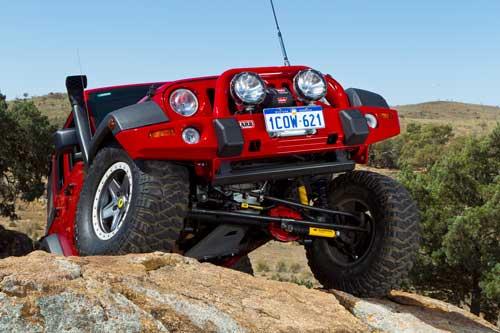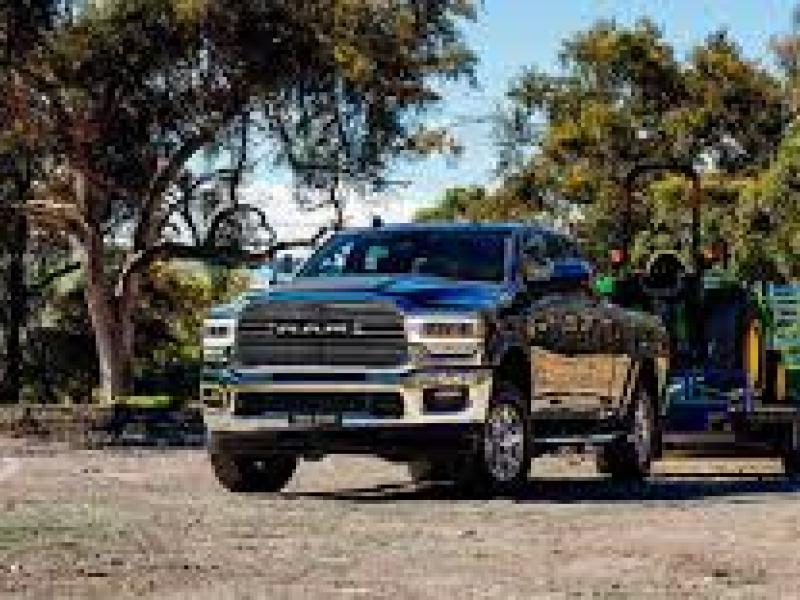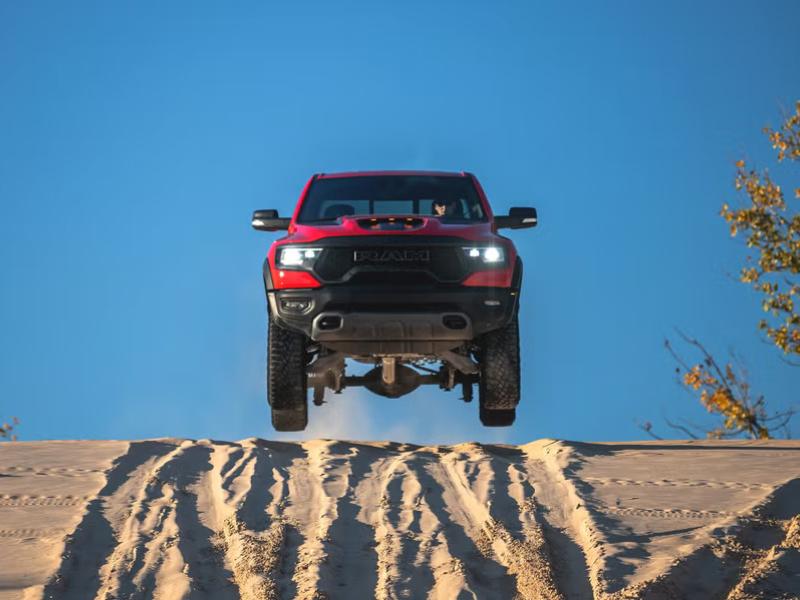I could make this into a really complicated article, but I’m not going to; instead I’m going to talk in fairly simple terms about the typical suspension we find on a 4WD, and how each type works.
Basically, there are two types of suspension, live axle and independent. There are many permutations on each theme, and in some vehicles the two are mixed (typically on modern utes), but those are the two basics.
A live axle is when there is a solid axle, with either leaf or coil springs attaching it to the chassis, or the chassis rails in the case of a monocoque or chassis-in-frame 4WD, and tubular shock absorbers between the bodywork and the axle, fixed either vertically or at an angle.
On more advanced types of live axles, typically with coil springs, there may be additional rods longitudinally linking the axle to the body. These are known as control arms, and their purpose is to prevent the axle from moving backwards or forwards in relation to the chassis as power is applied.
There may also be a rod which is attached east-west, to the chassis on one side and the axle on the other. This is known as a Panhard rod, and its purpose is to prevent the axle squirming side to side under cornering.
When all (or most of) these are present we refer to the suspension as “multi-link”.
An independent suspension, however, does not have a solid axle. Instead it has the differential bolted to the chassis, and feeds power through drive shafts each side to the wheels via universal joints which can operate at angles. Coil springs are usually used, at the rear with a multi-link suspension, and at the front with an anti-roll bar.
The coil springs act onto east-west control arms which are attached to a bracket in line with the differential, or sometimes onto the differential itself. These suspension arms are responsible for the up and down movement of the suspension, and the wheels are attached to them.
Independent suspension may also use a torsion bar, which is a long rod fixed onto the bodywork at one end and connected to a suspension arm at the other. It is made of spring steel, and acts like a coil spring, but takes up less room.
OK, that’s what they are. Let’s now look at advantages and disadvantages of the various types.
Live axle with leaf springs.
This is the simplest and arguably the strongest, and it’s very good for load carrying. Not only is it of simple (and cheap) construction – fore-aft spring steel leaves connected to the axle by a simple U-bolt – but it also locates the axle, preventing it moving backwards and forwards relative to the chassis. However it doesn’t do a very good job of this because the leaves lengthen slightly as they compress, which is the reason leaf sprung vehicles don’t handle as well as other types.
There’s also a secondary self-dampening effect as the leaves rub together as they compress, making it more difficult to get really precise shock absorber settings, resulting in a bumpier ride.
Live axle with coil springs.
This is very popular with 4WDers who go into really rough country. Although it requires a fairly complicated setup to properly locate the axle, as outlined above, it gives better ride and handling than a leaf spring live axle, as the springs don’t have any friction when they compress.
The ground clearance of a live axle is limited by the space underneath the centre of the differential, and the only way to improve this is to put on bigger wheels and/or tyres.
When a wheel on one side of a live axle goes up, it naturally pushes the opposite side down, increasing the pressure, and in hard ground improving traction. In muddy conditions, however, it can have the effect of forcing the “down” wheel further into the soft ground.
Independent suspension
Because each wheel can go up and down independently of each other (compared to the linked pair on a live axle) a coil spring suspension gives a less bumpy ride as each wheel is less likely to transmit bumps to the opposing wheel. At the same time there can be a longer suspension travel as it is not limited by the solid axle touching up against the underneath of the body, but rather by the binding of the spring and the amount of space under the wheel arch.
At the same time lifting one wheel does not affect that on the other side, so it is more likely that the wheels can all remain in contact with the ground, improving traction.
Similarly, because the differential is attached to the body, it allows for greater ground clearance.
However, it does not have the advantage of the live axle of one wheel raised up by an object such as a boulder or bank forcing the opposite one down onto the ground; each wheel relies on only gravity and the natural extension of the spring to push it down and gain traction.
This was solved to a large degree when Land Rover introduced the Range Rover, which used very soft springs which allowed the wheels to more easily contact the ground, while a special device (a self-adjusting air spring called a Boge strut) was used to compensate for loads on the rear axle and overcome the natural tendency of the body to roll on the suspension.
Another advantage of independent suspension is that it reduces unsprung mass, i.e. the weight of the vehicle that isn’t supported by the springs.
On a live axle setup the axle and its differential, the wheels (and brakes etc) are all unsprung weight. On independent suspension only the wheels and their short stub axles are unsprung.
What this means is that on a live axle everything has to work harder (springs and shock absorbers, plus bushes and linkages) to keep this (quite substantial) weight under control, while the independent unit has less work to do because there is less weight for it to control.
The result is better and crisper handling, especially on-road, whether this be dirt or tar seal.
One particular disadvantage of independent suspension in relation to this feature is that it is harder to lift the bodywork – usually done in New Zealand to make it harder for the vehicle to get stuck because the bottom of the vehicle is on the ground, often in deep sand or mud. This is because the differentials are fixed to the body, so the more you lift it, the more you change the angle of the axle drive shafts and even the steering, to a point where the vehicle can become unstable and unsafe to drive.
What happens is that instead of the tyres being flat on the ground, in extreme conditions they can actually be running only on their outer edges. Not good for roadholding, handling or traction, and giving a strong likelihood that the vehicle might roll over even under moderate cornering.
Self-adjusting and variable height air suspension has derived from independent coil sprung setups, the adjustable air bags taking the place of springs and sometimes shock absorbers too, allowing changes in ride height and suspension stiffness at the touch of a button or the turn of a switch to provide the ultimate in off-road ability.
However, since these are largely beyond the scope of this feature, we’ll leave them for another day.
What are shock absorbers?
When a vehicle hits a bump or hole in the ground this causes the springs to compress, then as the vehicle moves on they rebound and regain their normal length. This absorbs most of the shock of hitting the bump, and makes the ride more comfortable. However, if there’s nothing to stop it the vehicle will carry on bouncing up and down for a while as the inertia built up by the first compression works its way out. Much like one of those super-bouncy rubber balls kids play with that seems to keep bouncing forever.
This, of course, would make the ride much LESS comfortable and could easily invoke a feeling of seasickness!
To prevent this, shock absorbers – also known as dampers – are employed. They fit between the spring and the bodywork, and limit the spring to only one compression and rebound per bump, so you don’t get the “rubber ball” effect.
Early shock absorbers were simple devices that worked by creating friction between two parts, and drivers would every now and again have to stop and tighten them up, often several times in a journey.
Then the hydraulic shock absorber was invented, firstly using a lever arm, and later the almost universally used telescopic.
It also works using friction, but in this case it’s the friction caused by forcing oil through a small hole from one chamber of the shock to another, via a series of valves. As the spring compresses, the piston inside the shock absorber tube is forced up, and oil flows into another chamber. Then as the spring rebounds, this oil is let out slowly (figuratively speaking – in fact it happens in milliseconds) – to slow down the spring movement.
From this system have developed adjustable shock absorbers which allow you to “dial in” the speed at which they limit the bounce, better controlling the wheels and therefore improving traction, and bigger and stronger shocks that just, well, do a better job.
One of the enemies of hydraulic shock absorbers is air. When a shock absorber works really hard, the air displaced each time the oil is forced from one chamber to another starts to aerate, causing bubbles. These bubbles make the oil frothy and less effective.
The usual way around this is to get rid of the air altogether by replacing it with a chamber or a bladder filled with nitrogen, which resists heat build-up better than old-fashioned air.
Some more modern shock absorbers now use foam cells in place of nitrogen, while others have twin tubes, and the more extreme competition types have a completely separate remote reservoir which keeps the oil cooler.
So what’s special about some shock absorbers compared to others? I used to know a guy who worked for Bilstein, the famous German competition shock absorber company. He knew how to get the right combination of valves to suit a given vehicle and application to make it perform at its best.
He was known as the “Wizard of Shocks”, and the best there was around at the time.
The size of the valves, and the speed with which they open and close, can alter the whole characteristic of a shock absorber. Couple that to the way the shocks are made – in 4WD terms, so they’re strong enough to survive really hard bumps – and you’ll easily see why sticking with reputable tried and tested makes is better than trying to make do with second hand parts from other vehicles.
Yes, it’s a bit of a “black art”. And all the more reason why you should talk to the experts. Choosing right can mean the difference between getting a vehicle that rides well and keeps its cool in severe off-road conditions, and one which lets you down.
What’s an antiroll bar?
I knew you’d ask this question.
So far we’ve talked about spring and shock absorbers, but I did mention antiroll bars in the beginning, and they DO play a very important part in keeping the vehicle the right way up, especially under fast on-road conditions.
A 4WD vehicle is always going to be a compromise between the demands of travelling quickly on tarmac and fast dirt roads getting to your destination, and the rough and tough demands of off-roading.
The purpose of the antiroll bar (also known as a sway bar, or stabiliser bar), which is usually used only on the front suspension of a 4WD, is to limit the weight shift from side to side as you go through a corner, and thus the amount of roll of the body. The antiroll bar is a bar which is shaped like a flat-bottomed “U”. The base of the “U” is attached to the chassis, behind the wheels, while the two sides of the “U” attach to the suspension.
If you didn’t have them, travelling would be very uncomfortable as the vehicle’s body would wallow its way through corners, and passengers would be thrown all over the place.
An anti-roll bar also limits wheels lifting going through corners, and thus losing traction.
The downside when you go off-road, however, is that the antiroll bar limits wheel travel as it will only flex so much before it stops the wheel from moving any further in either direction. This means your vehicle is not so effective at climbing humps and bumps when travelling off-road.
The answer is to disconnect the antiroll bar when you are going into extreme off-road conditions. Depending on your vehicle there are a number of ways you can do this. On our modified Project 8K Jeep it’s done by pulling out pins which normally lock the antiroll bar to the suspension. The bar is then lashed out of the way using cable ties.
However, the latest 4WDs are being fitted with devices that automatically disconnect the antiroll bar when extreme conditions are encountered, such as Toyota’s KDSS system used on the latest ‘Cruiser 200 and Prado, while Nissan has got rid of the antiroll bar altogether on its latest Patrol and instead uses a cross-linked hydraulic system which does the same job, and being hydraulic can be computer controlled to suit conditions.
Of course some people merely take the antiroll bar off altogether, but be warned, this means you have to be EXTREMELY careful when driving your vehicle at travelling speeds as it will not corner well and handling will be, well, pathetic!
Bump stops
Bump stops are often ignored. After all, they are just big pieces of rubber which stop your suspension or axle from hitting the chassis when the springs are fully compressed. No need to worry about them eh?
Wrong! Bump stops are a vital part of the suspension, and unless they are in good condition, they can allow shock forces into the bodywork which not only will make for a very uncomfortable and noisy ride in the rough stuff, but will eventually damage the bodywork itself, and even the mounting points between the bodywork and the chassis.
To make them work even more effectively a variety of replacement parts are available made from polyurethane, which is tougher and more progressive in operation than rubber. Or you can go the whole hog and fit hydraulic bumps stops which are adjustable to the conditions you’re going to find yourself in.
I’m told they are fantastic, especially on the really rough stuff and in competition. Phil Clark tells us more on pXX.
Air assistance springs
These are a very useful device, for they enable you to have something of the best of both worlds. You can have quite a compliant suspension setup for more comfortable on and off-road driving (and better traction under some conditions), but when you want to carry a load or tow a heavy trailer or boat, you merely pump up the assistance springs, which are essentially air bags placed inside or alongside the normal springs, and this increases the spring rates and thus their carrying capacity.
Not cheap, but definitely worthwhile if you use your 4WD for a variety of purposes.







